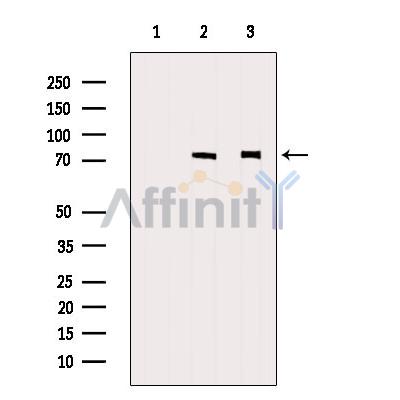HEXIM1 Antibody - #AF0568
| Product: | HEXIM1 Antibody |
| Catalog: | AF0568 |
| Description: | Rabbit polyclonal antibody to HEXIM1 |
| Application: | WB IHC IF/ICC |
| Reactivity: | Human, Mouse, Rat, Monkey |
| Prediction: | Bovine, Horse, Rabbit, Dog |
| Mol.Wt.: | 40kDa, 70 kDa; 41kD(Calculated). |
| Uniprot: | O94992 |
| RRID: | AB_2834193 |
Related Downloads
Protocols
Product Info
*The optimal dilutions should be determined by the end user.
*Tips:
WB: For western blot detection of denatured protein samples. IHC: For immunohistochemical detection of paraffin sections (IHC-p) or frozen sections (IHC-f) of tissue samples. IF/ICC: For immunofluorescence detection of cell samples. ELISA(peptide): For ELISA detection of antigenic peptide.
Cite Format: Affinity Biosciences Cat# AF0568, RRID:AB_2834193.
Fold/Unfold
Cardiac lineage protein 1; CLP 1; CLP1; EDG 1; EDG1; Estrogen down-regulated gene 1 protein; FLJ13562; Hexamethylene bis acetamide inducible 1; Hexamethylene bis acetamide inducible protein; Hexamethylene bis acetamide inducible transcript 1; Hexamethylene bis-acetamide-inducible protein 1; HEXI1_HUMAN; HEXIM 1; Hexim1; HEXIM1 protein; HIS 1; HIS1; HMBA inducible; MAQ 1; MAQ1; Menage a quatre 1; Menage a quatre protein 1; Protein HEXIM1;
Immunogens
A synthesized peptide derived from human HEXIM1, corresponding to a region within C-terminal amino acids.
Ubiquitously expressed with higher expression in placenta. HEXIM1 and HEXIM2 are differentially expressed. Expressed in endocrine tissues.
- O94992 HEXI1_HUMAN:
- Protein BLAST With
- NCBI/
- ExPASy/
- Uniprot
MAEPFLSEYQHQPQTSNCTGAAAVQEELNPERPPGAEERVPEEDSRWQSRAFPQLGGRPGPEGEGSLESQPPPLQTQACPESSCLREGEKGQNGDDSSAGGDFPPPAEVEPTPEAELLAQPCHDSEASKLGAPAAGGEEEWGQQQRQLGKKKHRRRPSKKKRHWKPYYKLTWEEKKKFDEKQSLRASRIRAEMFAKGQPVAPYNTTQFLMDDHDQEEPDLKTGLYSKRAAAKSDDTSDDDFMEEGGEEDGGSDGMGGDGSEFLQRDFSETYERYHTESLQNMSKQELIKEYLELEKCLSRMEDENNRLRLESKRLGGDDARVRELELELDRLRAENLQLLTENELHRQQERAPLSKFGD
Predictions
Score>80(red) has high confidence and is suggested to be used for WB detection. *The prediction model is mainly based on the alignment of immunogen sequences, the results are for reference only, not as the basis of quality assurance.
High(score>80) Medium(80>score>50) Low(score<50) No confidence
Research Backgrounds
Transcriptional regulator which functions as a general RNA polymerase II transcription inhibitor. In cooperation with 7SK snRNA sequesters P-TEFb in a large inactive 7SK snRNP complex preventing RNA polymerase II phosphorylation and subsequent transcriptional elongation. May also regulate NF-kappa-B, ESR1, NR3C1 and CIITA-dependent transcriptional activity. Plays a role in the regulation of DNA virus-mediated innate immune response by assembling into the HDP-RNP complex, a complex that serves as a platform for IRF3 phosphorylation and subsequent innate immune response activation through the cGAS-STING pathway.
Nucleus. Cytoplasm.
Note: Binds alpha-importin and is mostly nuclear (PubMed:16362050).
Ubiquitously expressed with higher expression in placenta. HEXIM1 and HEXIM2 are differentially expressed. Expressed in endocrine tissues.
The coiled-coil domain mediates oligomerization.
Belongs to the HEXIM family.
Restrictive clause
Affinity Biosciences tests all products strictly. Citations are provided as a resource for additional applications that have not been validated by Affinity Biosciences. Please choose the appropriate format for each application and consult Materials and Methods sections for additional details about the use of any product in these publications.
For Research Use Only.
Not for use in diagnostic or therapeutic procedures. Not for resale. Not for distribution without written consent. Affinity Biosciences will not be held responsible for patent infringement or other violations that may occur with the use of our products. Affinity Biosciences, Affinity Biosciences Logo and all other trademarks are the property of Affinity Biosciences LTD.










